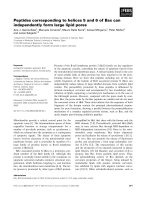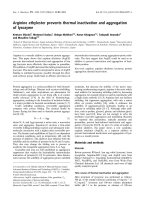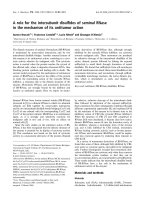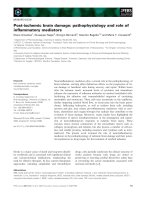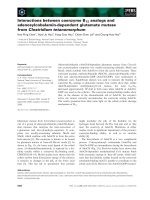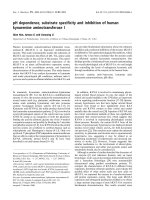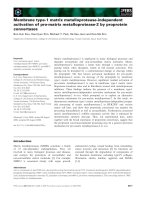báo cáo khoa học: " Multi-drug resistance 1 genetic polymorphism and prediction of chemotherapy response in Hodgkin’s " pot
Bạn đang xem bản rút gọn của tài liệu. Xem và tải ngay bản đầy đủ của tài liệu tại đây (336.08 KB, 8 trang )
RESEARCH Open Access
Multi-drug resistance 1 genetic polymorphism
and prediction of chemotherapy response in
Hodgkin’s Lymphoma
Nizar M Mhaidat
1*
, Osama Y Alshogran
1
, Omar F Khabour
2
, Karem H Alzoubi
1
, Ismail I Matalka
3
,
William J Haddadin
4
, Ibraheem O Mahasneh
5
and Ahmad N Aldaher
1
Abstract
Background: The human multi-drug resistance gene (MDR1), which encodes the major trans-membrane
transporter P-glycoprotein (P-gp), was found to be associated with susceptibility to cancer and response to
chemotherapy. The C3435T Polymorphism of MDR1 gene was correlated with expression levels and functions of
P-gp. Here, we studied the association between MDR1 C3435T polymorphism and susceptibility to Hodgkin
lymphoma (HL) and patient’s response to ABVD chemotherapy regimen.
Methods: a total of 130 paraffin embedded tissue samples collected from HL patients were analyzed to identify
the C3435T polymorphism. As a control group, 120 healthy subjects were enrolled in the study. The C3435T
Polymorphism was genotyped by polymerase chain reaction and restriction fragment length polymorphism (PCR-
RFLP) method. Data analysis was carried out using the statistical package SPSS version 17 to compute all
descriptive statistics. Chi-square and Fisher exact tests were used to evaluate the genotype distribution and allele
frequencies of the studied polymorphism.
Results: these studies revealed that the frequency of T allele was significantly higher in HL patients compared to
the controls (P < 0.05). In addition, the frequency of CT and TT genotypes were also significantly higher in HL
patients compared to the controls (P < 0.05). No association between C3435T polymorphism and response to
ABVD was detected among HL patients (P > 0.05).
Conclusions: these results suggest that MDR1 C3435T polymorphism might play a role in HL occurrence; however
this polymorphism is not correlated with the clinical response to ABVD.
Keywords: Lymphoma, C3435T SNP, MDR-1
Background
Lymphomas are heterogeneous group of hematological
malignancies that arise from malignant transformation of
immune cells and account for 17% of all cancers in teen-
agers, and around 10% of childhood cancers [1]. Lympho-
mas are classified into two main types, Hodgkin’ s
lymphoma (HL) and non-Hodgkin’slymphoma(NHL).
The incidence of HL has risen gradually over the last few
decades, representing a bimodal incidence peak, in early
and late adulthood [1].
Several modalities are available to improve the overall
survival in HL patients including radiothe rapy, che-
motherapy or combination of both [2]. However, the
most commonly used regimen in the treatment of
advanced stages of HL is the ABVD regimen containing
doxorubicin (adriamycin), bleomycin, vinblastine and
darcarbazine [3]. While more than 70% of HL patients
are cured after treatment [3], about 30% of them might
experience relapse after achieving initial complete remis-
sion (CR) [4]. Thi s was attributed to the development of
drug resistance, which might result from change in drug
target sites or increased drug efflux by overexpression of
drug transporters [5-7].
* Correspondence:
1
Clinical Pharmacy Department, Faculty of Pharmacy, Jordan University of
Science and Technology, Irbid, 22110, Jordan
Full list of author information is available at the end of the article
Mhaidat et al. Journal of Experimental & Clinical Cancer Research 2011, 30:68
/>© 2011 Mhaidat et al; licensee Bi oMed Central Ltd. Thi s is an Open Access article distributed under the terms of the Creative Commons
Attribution License ( which permits unrestricted use, distribution, and reproduction in
any medium, provided the original work is properly cited.
The multi-drug resistance (MDR) protein is a trans-
porter that plays a primary role in drug resistance by
affecting drug transport to cancer cells. MDR1 p rotein,
called P-glycoprotein (P-gp), belongs to ATP-binding
cassette superfamily [8]. A number of polymorphisms in
the MDR1 gene were found to be of clinical importance,
since they can alter drug ab sorption, distribution and
elimination [9]. For example, the MDR1 C3435T poly-
morphism has been shown to affect the efficiency of
chemotherapy in patients with lymphoproliferative dis-
eases in a sample of the Europeoids of west Serbia [10].
While the association between the MDR1 C3435T
polymorphism and NHL is well documented, the asso-
ciation between this polymorphism and HL has not
been examined yet. In the present study, we investigated
the association between the MDR1 C3435T polymorph-
ism and the risk to develop HL, as well as the clinical
response to ABVD chemotherapy regimen.
Methods
Studied groups
A total of 130 samples of paraffin-embedded tissue col-
lected from HL patients were obtained from the Depart-
ments of Pathology at both Royal Medical Services and
King Abdullah University H ospital. Patients included in
the study are those of age more than 15-year old with HL,
who received only ABVD regimen as initial chemotherapy.
Patients were divided into two groups; complete response
(n = 96) and relapsed disease (n = 34) according to Inter-
national Workshop Criteria (IWC) [11].
Complete response (CR) was defined as 1) complete dis-
appearance of all detectable evidence of disease on com-
puted tomography (CT), 2) all disease-related symptoms,
3) normalization of biochemical abnormalities , 4) normal
bone marrow biopsy, and 5) regression of nodes on CT of
more than 1.5 cm in their axial diameter to less than 1.5
cm, and nodes of 1.1-1.5 to less than 1 cm. Relapsed dis-
ease (RD) was defined as: 1) the appearance of any new
lesion 2) or increase in the size of mo re than 50% of pre-
viously involved sites or nodes in patients who achieved
CR or Cru (uncertain). CRu corresponds to CR criteria
but with a residual m ass more than 1.5 cm in greatest
axial diameter that has regressed by more than 75% [11].
Peripheral blood samples were collected from 120
healthy young volunteers as a control group from the
same patient’s geographical areas. Informed written con-
sents were obtained from the participants in accordance
with the requirements of the Institutional Review Boards
of Jordan University of Science and Technology.
DNA extraction
DNA was extracted from paraffin embedded tissue sam-
ples using QIAamp DNA FFPE Tissue Kit (QIAGEN,
California, USA) according to standard protocol
provided by the manufacturer. Approximately, 3-5 sec-
tions of 5 μmthickwerecutfromeachsampleand
used for DNA extraction. Venous blood samples were
collected in EDTA tubes and obtained from young
healthy control group. DNA w as extracted from all
blood samples using Promega wizard genomic DNA
purification kit (Promega, Madison, USA). DNA samples
were stored at -20°C until used.
Genotyping
The polymorphism C3435T was analyzed using polymer-
ase chain reaction and restriction fragment length poly-
morphism (PCR-RFLP) method. Desired D NA target
sequence (197) was amplified as described by Cascorbi
et al.[12]usingaforwardprimer(5’ -TGT TTT CAG
CTG CTT GAT GG -3’) and a reverse primer (5’ -AAG
GCA TGT ATG TTG GCC TC-3’). The reaction mixture
of 25 μL contained 50 ng of genomic DNA, 0.5 μLofeach
primer, 12.5 μL of the green master mix, and 1.5-9.5 μLof
deionized water. The reaction mixture was initially dena-
tured at 94°C for 2 minutes, followed by 35 cycles of dena-
turation at 94°C for 30 s, annealing at 60°C for 30 s and
extension at 72°C for 30 s. The termination elongation
was performed at 72°C for 7 minutes. Successful amplifica-
tion was confirmed by detection of a 197 bp band on a 2%
agarose gel using a 100 bp DNA ladder. 10 μL of each
PCR product was digested with 5 units of Sau3AI at 37°C
overnight. The digested products were separated using
2.5% agarose gel and detected by ethidium bromide stain-
ing. Fragments obtained were 158 bp and 39 bp to the
wild type genotype C/C, 197 bp to the mutant genotype
T/T and 197 bp, 158 bp and 39 bp to the C/T genotype.
Statistical analysis
Data analysis was carried out using the statistical pack-
age SPSS version 17 to compute all descriptive statis-
tics. Chi-square and Fisher exact tests were used to
evaluate the genotype distribution and allele frequen-
cies of the studied polymorphism. A P value of < 0 .05
was considered statistically significant. Hardy-Wein-
berg equilibrium was assessed using the chi-square
test. The C3435T genotypes were found to be in
Hardy- Weinberg equilibrium.
Results
A hundred and thirty patients diagnosed with HL, the
median age is 30 years, were included in the study. Fifty
five percent are males and 47.7% have early stages of HL
and complaining of B-symptoms. Most of the patients
(76.2%) received 6 cycles of ABVD regimen. Other base-
line characteristics of the patients are shown in Table 1.
As a control, 120 healthy volunteers from the same geo-
graphical areas were enrolled (54% are males with median
age of 23.5 years).
Mhaidat et al. Journal of Experimental & Clinical Cancer Research 2011, 30:68
/>Page 2 of 8
AsshowninFigure1,samplesfromparaffin
embedded tissues and blood, were successfully geno-
typed using PCR-RFLP method. The mutant T allele
does not carry the restriction site for Sau3AI e nzyme
and remains as 197 bp fragmen t, while the wild C allele
cuts into two fragments of 158 and 39 bp.
Results in Table 2 revealed that both C and T alleles
are common in the studied population with a pproxi-
mately equal distribution. However, the patient group
showed significantly (P value < 0.05) higher frequencies
of both mutant T allele (65%) and TT homozygous
mutant genotype (41%) compared to the control group.
This indicates that the T allele in the C3435T poly-
morphism is associated with and HL occurrence.
No significant association between the C3435T geno-
types (CC, CT and TT) and alleles (C and T) wit h
patient’s baseline characteristics including patient’sage,
gender, specimen histology, stage of the disease and pre-
sence or absence of B-symptoms (Table 3 and 4), P
value > 0.05.
To verify whether different baseline characteristics of
the patients might contribute to chemotherapy respo nse,
complete remission and disease relapse were studied
according to the followin g criteria : age, gender, specimen
histology, disease stage and presence or absence of B-
symptoms (Table 5). None of these factors were asso-
ciated with clinical response in HL patients (P value >
0.05).
Table 6 shows the genotype and allele frequencies of
the C3435T polymorphism i n HL patients with com-
plete remission compared to those with relapse. No sig-
nificant difference of CT and TT genotype distribution
and allele frequency was found between the two groups
(P value > 0.05).
To identify possible correlation between the genotype
and allele frequencies of the C3435T polymorphism and
the p rogression free survival in relapsed group; patients
were divided into two groups. The first include those
having the relapse after one year of complete remission
and the other group having the relapse during the first
year of complete remission (Table 7). However, no sig-
nificant difference in the frequencies of C3435T geno-
types and the alleles was found. Thus, C3435T
polymorphism seems to play no role in the progression
free survival in the relapsed HL patients.
Discussion
In this study, we investigated for the first time whether
functional polymorphism C3425T in MDR1 gene could
affect patient’ s susceptibility to HL and/or modify its
response to chemotherapeutic agents. The results suggest
that C3435T polymorphism plays a role in susceptibility
Table 1 Demographic criteria of the patients
Variable Patients with
Complete
Remission (CR)
N (%)
Patients with Relapsed
Disease (RD) N (%)
Number 96 34
Age at
diagnosis
Median 31 27.5
15-20 16 (16.7) 17 (50)
21-30 32 (33.3) 5 (14.7)
31-40 18 (18.8) 5 (14.7)
> 40 30 (31.2) 8 (20.6)
Gender
Males 50 (52.1) 21 (61.8)
Females 46 (47.9) 13 (38.2)
Stage
Early stages (I
&II)
41 (42.7) 20 (58.8)
Advanced
stages (III & IV)
38 (39.6) 12 (35.3)
Missed data 17 (17.7) 2 (5.9)
Presence of B
symptoms
Yes 54 (56.3) 19 (55.9)
No 31 (32.3) 13 (38.2)
Missed data 11 (11.4) 2 (5.9)
Bone marrow
involvement
Yes 5 (5.2) 4 (11.8)
No 91 (94.8) 30 (88.2)
Histology
Nodular
sclerosis
46 (47.9) 16 (47.1)
Mixed cellularity 25 (26) 6 (17.6)
Lymphocyte
rich
5 (5.2) 3 (8.8)
Lymphocyte
depleted
4 (4.2) 0 (0)
Nodular
lymphocyte
predominance
1 (1) 5 (14.7)
Classical 7 (7.3) 4 (11.8)
Missed data 8 (8.3) -
Chemotherapy
regimen
ABVD: All the
patients
ABVD: Initially all the patients at
relapse: ICE
a
(8), ESHAP
b
(8),
COPP
c
(3), ABVD
d
(8), Others: (7).
Number of
ABVD cycles
< 6 cycles 10 (10.4) 6 (17.6)
6 cycles 77 (80.2) 22 (64.7)
> 6 cycles 9 (9.4) 5 (14.7)
a
Adriamycin, Bleomycin, Vinblastine, Decarbazine;
b
Ifosfamide, Carboplatin,
Etoposide;
c
Etoposide, Cisplatin, Cytarabine, Methylprednisolone;
d
Cyclophosphamide, Vincristine, Prednisolone, Procarbazine.
Mhaidat et al. Journal of Experimental & Clinical Cancer Research 2011, 30:68
/>Page 3 of 8
to HL but not its response to ABVD chemotherapy. We
analyzed MDR1 C3435T polymorphism in DNA isolated
from paraffin embedded tissues taken from patient’ s
lymph nodes while the same polymorphism was analyzed
in the controls from peripheral blood tissues. This might
raise some concern that the DNA from the two ti ssues is
not equivalent because mutations are common during
cancer progression. H owever, unlike most o ther malig-
nant tumors, HL is characterized by low number
of malignant cells that are surrounded by many non-
neoplastic lymphocytes (reviewed in [13]).
The results indicate approximately equal distribution of
the C and T alleles of C3425T polymorphism in the Jor-
danian population. This distribution is similar to that of
Japanese [14], Caucasian [12] , Chinese [15], Polish [16]
and Malay [17] populations. However, the frequency of
the T allele found in the present study is higher than that
reported in Taiwanese [18], African [19], Jewish [20], Ira-
nian [21], and Polish [22] populations, but lower than
that of Czech [23] and Indian [17] populations (Table 8).
Thus, the distributio n of C3435T polymorphism seems
to fall somewhere in the middle when compared with the
Asian and European populations, which might be
explained by the unique geographical location of Jordan
at the crossing of Asia and Europe.
Several genetic and environmental factors such as
exposure to pesticides, wood dusts and chemicals were
found to be associated with development of HL [ 24]. In
here, we observed that C3435T polymorphism is signifi-
cantly associated with susceptibility to HL. The homozy-
gous mutant TT genotype and allele T frequencies were
found to be higher in HL patients. Thus, our data may
indicate that the C allele of C3435T polymorphism ha s
protective role against HL. This could be explained by
the low expression of T allele compared to C allele;
thereby individuals with T allele are more prone to
environmental toxins and carcin ogens associated with
HL. Previous studies suggest that the C3435T poly-
morphism is in linkage disequilibrium with other MDR1
polymorphisms such as C1236T and G2677T in exons
12 and 21, respectively. Thus, the contribution of those
polymorphisms to susceptibility to HL observed in our
study cannot be r uled out. In agreement with our
Figure 1 Gel electrophoresis of C3435T polymorphism from tissue samples. Left: The last lane from the right is 50 bp DNA ladder. Samples
in lanes 1, 3 and 5 represent the PCR products and samples in lanes 2, 4 and 6, are the digest products of each sample, respectively. Sample in
lane 2 is the mutant homozygous uncut TT genotype (197 bp). Sample in lane 4 represents the wild type cut CC genotype (158 bp and 39 bp).
Sample in lane 6 represents heterozygous CT genotype (197 bp, 158 bp and 39 bp). Right: Gel electrophoresis of C3435T polymorphism from
blood samples. The first lane from the left is 50 bp DNA ladder. Samples in lanes 1, 3 and 5 represent the PCR products and samples in lanes 2,
4 and 6, are the digest products of each sample, respectively. Sample in lane 2 is the mutant homozygous uncut TT genotype (197 bp). Sample
in lane 4 represents the wild type cut CC genotype (158 bp and 39 bp). Sample in lane 6 represents heterozygous CT genotype (197 bp, 158 bp
and 39 bp).
Table 2 Genotype and allele frequencies of C3435T
polymorphism among HL patients and controls
Genotypes & Alleles HL patients (130)
N (%)
Controls (120)
N (%)
P-value
CC 15 (11.5) 37 (30.8)
CT 62 (47.7) 48 (40.0) 0.001
TT 53 (40.8) 35 (29.2)
Allele C 92 (35.4) 122 (50.8) 0.000
Allele T 168 (64.6) 118 (49.2)
Mhaidat et al. Journal of Experimental & Clinical Cancer Research 2011, 30:68
/>Page 4 of 8
results, Turgut, et al. [25] found a significant association
between C3435T polymorphism and breast cancer. In
the patient group, T allele frequency was significantly
higher than controls. Similarly, the TT genotype of
C3435T polymorphism was found to be associated with
colon cancer risk [16]. The TT genotype was also asso-
ciated with other malign ancies such as acute lympho-
blastic leukemia [22], renal cell carcinoma [26], and
other diseases as ulcerative colitis [21]. In contrast,
C3435T polymorphism w as not associated with breast
cancer in Iranian population [27]. Furthermore, C3435T
variant was also not associated with acute leukemia in
Turkish patients [ 28] and in childhood leukemia [29].
Thus, association between C3435T polymorphism and
cancer development might have a population specific
component. Moreover, a study by Humeny et al. [30]
showed that MDR1 C3435T polymorphism is stable
during carcinogenesis. Thus, it is unlikely that the
observed strong association between HL and MDR1
Table 3 Characteristics of patients according to C3435T genotypes
Characteristics CC genotype
N (%)
CT genotype
N (%)
TT genotype
N (%)
P-value
Age at diagnosis
< 30 (n = 62) 7 (46.7) 28 (45.2) 27 (50.9) 0.823
≥ 30 (n = 68) 8 (53.3) 34 (54.8) 26 (49.1)
Gender
Males (n = 71) 7 (46.7) 29 (46.8) 35 (66) 0.095
Females (n = 59) 8 (53.3) 33 (53.2) 18 (44)
Histology
NS
a
(n = 62) 9 (64.3) 32 (72.7) 21 (60) 0.481
MC
b
(n = 31) 5 (35.7) 12 (27.3) 14 (40)
Stage
Early stages (I &II) (n = 61) 7 (50) 30 (58) 24 (53.3) 0.842
Advanced stages (III & IV) (n = 50) 7 (50) 22 (42) 21 (46.7)
Presence of B-symptoms
Yes (n = 73) 9 (60) 36 (64.3) 28 (60.9) 0.920
No (n = 44) 6 (40) 20 (35.7) 18 (39.1)
a
Nodular sclerosis;
b
Mixed cellularity.
Table 4 Characteristics of patients according to C3435T
alleles
Characteristics C allele
N (%)
T allele
N (%)
Total P-value
Age at diagnosis
< 30 42 (45.7) 82 (48.8) 124 0.626
≥ 30 50 (54.3) 86 (51.2) 136
Gender
Males 43 (46.7) 99 (58.9) 142 0.059
Females 49 (53.3) 69 (41.1) 118
Histology
NS
a
50 (69.4) 74 (64.9) 124 0.134
MC
b
22 (30.6) 40 (35.1) 62
Stage
Early stages (I &II) 44 (55) 78 (54.9) 122 0.992
Advanced stages (III & IV) 36 (45) 64 (45.1) 100
Presence of B-symptoms
Yes 54 (62.8) 92 (62.2) 146 0.924
No 32 (37.2) 56 (37.8) 88
a
Nodular sclerosis;
b
Mixed cellularity.
Table 5 The correlation between clinical outcome and
patient’s characteristics
Baseline Factors Complete
Remission
N (%)
Relapsed
Disease
N (%)
Total P-
value
Age at diagnosis
< 30 43 (44.8) 19 (55.9) 62 0.266
≥ 30 53 (55.2) 15 (44.1) 68
Gender
Males 50 (52.1) 21 (61.8) 71 0.330
Females 46 (47.9) 13 (38.2) 59
Histology
NS
a
46 (64.8) 16 (72.7) 62 0.490
MC
b
25 (35.2) 6 (27.3) 31
Stage
Early stages (I &II) 41 (51.9) 20 (62.5) 61 0.309
Advanced stages (III
& IV)
38 (48.1) 12 (37.5) 50
Presence of B-
symptoms
Yes 54 (63.5) 19 (59.4) 73 0.679
No 31 (36.5) 13 (40.6) 44
a
Nodular sclerosis;
b
Mixed cellularity.
Mhaidat et al. Journal of Experimental & Clinical Cancer Research 2011, 30:68
/>Page 5 of 8
C3435T polymorphism is due to mutations at the exam-
ined locus that are related to cancer progression.
A variety of mechanisms that may account for resis-
tance of c ancer cells to chemotherapy were described
[31]. The most important one is the increase efflux of
chemotherapeutic agents outside the cells by increas-
ing the expression level of the major membrane trans-
porter P-glycoprotein [6]. The MDR1 C3435T variant
was found to alter P-gp function and expression,
which might affect the disease response by modifying
the pharmacokinetics of anticancer drugs. Therefore,
several studies have shown the effect of C3435T
MDR1 variant on disease outcome. In our study, we
investigated the e ffect of C3435T variant on HL out-
come in patients who received ABVD regimen con-
taining common P-gp substrates adriamycin and
vinblastine. According to the current results, C3435T
variant was not associated with HL outcome in two
groups of patients one wit h complete remission and
the other with relapse. However, previous reports have
shown that the C3435T polymorphism alters the
response in different cancers. For example, the wild
type genotype CC was associated with better che-
motherapy response in patients with NSCLC [32,33]
and in patients with SCLC [34]. On the other hand,
CC genotype was linked significantly with increased
risk of re lapse in AML patients [35]. Furt hermore, our
study revealed no significant association between pro-
gression free survival and C3435T genotype and allele
frequencies. However, previous studies have shown the
effect of C3435T variant on survival time in cancer
patients. The CC genotype was associated with a
shorter overall survival in patient’ s with multiple
myloma [36] and in patients with ALL [22] compared
to both CT and TT genotypes. This difference in the
results may be related to the variation in the genetic
background of the studied groups, or life style or due
to other unknown factors.
Results of this study show no significant association
between HL response and patient’ s characteristics
such as age, gender, HL stage, specimen histology
and presence or absence of B-symptoms. In addition,
the distribution o f C3435T genotypes and alleles w as
notassociatedwithpatient’s characteristics. There-
fore, possibilities exist that other polymorphisms in
the MDR1 gene might be invo lved in modulating HL
response to drugs in the Jordanian population. Thus,
scanning the MDR1 gene to sea rch for common and
newvariantsintheJordanianpopulationisimpor-
tant for future pharmacogenetic studies in this
population.
In conclusion, results of this study show that C3435T
polymorphism is associated with susceptibility to HL in
Jordanian population. However, this variant is not corre-
lated with the drug response or clinical parameters in
HL patients.
Table 6 Genotype and allele frequencies of C3435T
polymorphism among patients according to the response
Genotypes and
Alleles
Complete
Remission
N (%)
Relapsed
Disease
N (%)
P-value
CC 12 (12.5) 3 (8.8)
CT 44 (45.8) 18 (52.9) 0.729
a
TT 40 (41.7) 13 (38.2)
Allele C 68 (35.4) 24 (35.3) 0.986
Allele T 124 (64.6) 44 (64.7)
a
P value based on fisher exact test.
Table 7 Genotype and allele frequencies of C3435T
polymorphism among the relapsed group according to
progression free survival
Genotypes
and Alleles
Progression free
survival ≤ 1 year
N (%)
Progression free
survival > 1 year
N (%)
P-value
CC 0 (0) 3 (18.8)
CT 12 (66.7) 6 (37.5) 0.083
a
TT 6 (33.3) 7 (43.7)
Allele C 12 (33.3) 12 (37.5) 0.720
Allele T 24 (66.7) 20 (62.5)
a
P value based on fisher exact test.
Table 8 The frequency of 3435T allele among ethnic
groups
Ethnicity 3435T allele
Frequency (%)
Reference
Taiwanese (n = 110) 37.3 (Huang et al., 2005)
Japanese (n = 100) 49.0 (Tanabe et al., 2001)
Caucasians (n = 461) 53.9 (Cascorbi et al., 2001)
Africans (n = 206) 17.0 (Ameyaw et al., 2001)
Chinese in Singapore
(n = 98)
54.0 (Balram et al., 2003)
Chinese in Mainland
(n = 132)
46.6 (Ameyaw et al., 2001)
French (n = 227) 46.0 (Jeannesson et al., 2007)
Ashkenazi Jewish
(n = 100)
35.0 (Ostrovsky et al., 2004)
Czech (n = 189) 56.5 (Pechandova et al.,
2006)
Polish (n = 204) 52.5 (Kurzawski et al., 2006)
West Siberian
Europeans
(n = 59)
59.0 (Goreva et al., 2003)
Iranian (n = 300) 33.5 (Farnood et al., 2007)
Polish (175) 40.0 (Jamroziak et al., 2004)
Indians (n = 87) 63.2 (Chowbay et al., 2003)
Chinese (n = 96) 53.1 (Chowbay et al., 2003)
Malays (n = 92) 51.1 (Chowbay et al., 2003)
Jordanian (n = 120) 49.2 Present study
Mhaidat et al. Journal of Experimental & Clinical Cancer Research 2011, 30:68
/>Page 6 of 8
Acknowledgements
We would like to acknowledge the Jordan University of Science &
Technology, Irbid, Jordan, for the financial support (Grant Number 176/2009).
Author details
1
Clinical Pharmacy Department, Faculty of Pharmacy, Jordan University of
Science and Technology, Irbid, 22110, Jordan.
2
Molecular Genetics, Faculty of
Applied Medical Sciences, Jordan University of Science and Technology,
Irbid, 22110, Jordan.
3
Pathology Department, Faculty of Medicine, Jordan
University of Science and Technology, Irbid, 22110, Jordan.
4
Histology and
Cytology Department, Princess Iman Center for Research and Laboratory
Sciences, King Hussein Medical Center, Amman, 11855, Jordan.
5
Hematology
and Oncology Department, Jordanian Royal Medical Services, 11855,
Amman, Jordan.
Authors’ contributions
NM, OK, OA, and AA carried out the molecular genetic studies, participated
in the sequence alignment and drafted the manuscript. IOM participated in
the sequence alignment. NM, OK, KA and OA participated in the design of
the study and performed the statistical analysis. WH and IIM have
participated in the study design and samples collection and preparation for
perform the study. NM and KA helped to draft the manuscript. All authors
read and approved the final manuscript.
Competing interests
The authors declare that they have no competing interests.
Received: 5 June 2011 Accepted: 16 July 2011 Published: 16 July 2011
References
1. Morley-Jacob C, Gallop-Evans E: Update on Lymphoma. Pediatrics and child
health 2008, 18:3.
2. Rueda A, Olmos D, Viciana R, and Alba E: Treatment for relapse in stage
I/II Hodgkin’s lymphoma after initial single-modality treatment. Clin
Lymphoma Myeloma 2006, 6:389-392.
3. Castagna L, Magagnoli M, Demarco M, and Santoro A: Lymphomas. update
on cancer therapeutics 2007, 101-110.
4. Quddus F, Armitage JO: Salvage therapy for Hodgkin’s lymphoma. Cancer
J 2009, 15:161-163.
5. Desoize B, Jardillier J: Multicellular resistance: a paradigm for clinical
resistance? Crit Rev Oncol Hematol 2000, 36:193-207.
6. Longley DB, Johnston PG: Molecular mechanisms of drug resistance.
J Pathol 2005, 205:275-292.
7. Ambudkar SV, Kimchi-Sarfaty C, Sauna ZE, and Gottesman MM: P-
glycoprotein: from genomics to mechanism. Oncogene 2003,
22:7468-7485.
8. Burger H, Foekens JA, Look MP, Meijer-van Gelder ME, Klijn JG,
Wiemer EA, Stoter G, Nooter K: RNA expression of breast cancer
resistance protein, lung resistance-related protein, multidrug
resistance-associated protei ns 1 and 2, and multidrug resistance gene
1 in breast cancer: correlation with chemothera peutic response. Clin
Cancer Res 2003, 9:827-836.
9. Ishikawa T, Hirano H, Onishi Y, Sakurai A, and Tarui S: Functional evaluation
of ABCB1 (P-glycoprotein) polymorphisms: high-speed screening and
structure-activity relationship analyses. Drug Metab Pharmacokinet 2004,
19:1-14.
10. Goreva OB, Grishanova AY, Mukhin OV, Domnikova NP, Lyakhovich VV:
Possible prediction of the efficiency of chemotherapy in patients with
lymphoproliferative diseases based on MDR1 gene G2677T and C3435T
polymorphisms. Bull Exp Biol Med 2003, 136:183-185.
11. Hampson FA, Shaw AS: Response assessment in lymphoma. Clin Radiol
2008, 63:125-135.
12. Cascorbi I, Gerloff T, Johne A, Meisel C, Hoffmeyer S, Schwab M,
Schaeffeler E, Eichelbaum M, Brinkmann U, Roots I: Frequency of single
nucleotide polymorphisms in the P-glycoprotein drug transporter MDR1
gene in white subjects. Clin Pharmacol Ther 2001, 69:169-174.
13. Chan WC: The Reed-Sternberg cell in classical Hodgkin’s disease. Hematol
Oncol 2001, 19:1-17.
14. Tanabe M, Ieiri I, Nagata N, Inoue K, Ito S, Kanamori Y, Takahashi M,
Kurata Y, Kigawa J, Higuchi S, Terakawa N, Otsubo K: Expression of P-
glycoprotein in human placenta: relation to genetic polymorphism of
the
multidrug resistance (MDR)-1 gene. J Pharmacol Exp Ther 2001,
297:1137-1143.
15. Balram C, Sharma A, Sivathasan C, Lee EJ: Frequency of C3435T single
nucleotide MDR1 genetic polymorphism in an Asian population:
phenotypic-genotypic correlates. Br J Clin Pharmacol 2003, 56:78-83.
16. Kurzawski M, Drozdzik M, Suchy J, Kurzawski G, Bialecka M, Gornik W,
Lubinski J: Polymorphism in the P-glycoprotein drug transporter MDR1
gene in colon cancer patients. Eur J Clin Pharmacol 2005, 61:389-394.
17. Chowbay B, Cumaraswamy S, Cheung YB, Zhou Q, Lee EJ: Genetic
polymorphisms in MDR1 and CYP3A4 genes in Asians and the influence
of MDR1 haplotypes on cyclosporin disposition in heart transplant
recipients. Pharmacogenetics 2003, 13:89-95.
18. Huang MJ, Yung LC, Chang YC, Yang YH, Ching SH: Polymorphisms of the
Gene Encoding Multidrug Resistance Protein 1 in Taiwanese. Journal of
Food and Drug Analysis 2005, 13:112-117.
19. Ameyaw MM, Regateiro F, Li T, Liu X, Tariq M, Mobarek A, Thornton N,
Folayan GO, Githang’a J, Indalo A, Ofori-Adjei D, Price-Evans DA,
McLeod HL: MDR1 pharmacogenetics: frequency of the C3435T mutation
in exon 26 is significantly influenced by ethnicity. Pharmacogenetics 2001,
11:217-221.
20. Ostrovsky O, Nagler A, Korostishevsky M, Gazit E, Galski H: Genotype and
allele frequencies of C3435T polymorphism of the MDR1 gene in various
Jewish populations of Israel. Ther Drug Monit 2004, 26:679-684.
21. Farnood A, Naderi N, Moghaddam SJ, Noorinayer B, Firouzi F, Aghazadeh R,
daryani NE, Zali MR: The frequency of C3435T MDR1 gene polymorphism
in Iranian patients with ulcerative colitis. Int J Colorectal Dis 2007,
22:999-1003.
22. Jamroziak K, Mlynarski W, Balcerczak E, Mistygacz M, Trelinska J, Mirowski M,
Bodalski J, Robak T: Functional C3435T polymorphism of MDR1 gene: an
impact on genetic susceptibility and clinical outcome of childhood
acute lymphoblastic leukemia. Eur J Haematol 2004, 72:314-321.
23. Pechandova K, Buzkova H, Slanar O, Perlik F: Polymorphisms of the MDR1
gene in the Czech population. Folia Biol (Praha) 2006, 52:184-189.
24. Landgren O, Caporaso NE: New aspects in descriptive, etiologic, and
molecular epidemiology of Hodgkin’s lymphoma. Hematol Oncol Clin
North Am 2007, 21:825-840.
25. Turgut S, Yaren A, Kursunluoglu R, Turgut G: MDR1 C3435T polymorphism
in patients with breast cancer. Arch Med Res 2007, 38:539-544.
26. Siegsmund M, Brinkmann U, Schaffeler E, Weirich G, Schwab M,
Eichelbaum M, Fritz P, Burk O, Decker J, Alken P, Rothenpieler U, Kerb R,
Hoffmeyer S, Brauch H: Association of the P-glycoprotein transporter
MDR1(C3435T) polymorphism with the susceptibility to renal epithelial
tumors. J Am Soc Nephrol
2002, 13:1847-1854.
27.
Tatari F, Salek R, Mosaffa F, Khedri A, Behravan J: Association of C3435T
single-nucleotide polymorphism of MDR1 gene with breast cancer in an
Iranian population. DNA Cell Biol 2009, 28:259-263.
28. Kaya P, Gunduz U, Arpaci F, Ural AU, Guran S: Identification of
polymorphisms on the MDR1 gene among Turkish population and their
effects on multidrug resistance in acute leukemia patients. Am J Hematol
2005, 80:26-34.
29. Urayama KY, Wiencke JK, Buffler PA, Chokkalingam AP, Metayer C,
Wiemels JL: MDR1 gene variants, indoor insecticide exposure, and the
risk of childhood acute lymphoblastic leukemia. Cancer Epidemiol Biomark
Prev 2007, 16:1172-1177.
30. Humeny A, Rödel F, Rödel C, Sauer R, Füzesi L, Becker C, Efferth T: MDR1
single nucleotide polymorphism C3435T in normal colorectal tissue and
colorectal carcinomas detected by MALDI-TOF mass spectrometry.
Anticancer Res 2003, 23:2735-40.
31. Larsen AK, Escargueil AE, Skladanowski A: Resistance mechanisms
associated with altered intracellular distribution of anticancer agents.
Pharmacol Ther 2000, 85:217-229.
32. Pan JH, Han JX, Wu JM, Huang HN, Yu QZ, Sheng LJ: MDR1 single
nucleotide polymorphism G2677T/A and haplotype are correlated with
response to docetaxel-cisplatin chemotherapy in patients with non-
small-cell lung cancer. Respiration 2009, 78:49-55.
33. Pan JH, Han JX, Wu JM, Sheng LJ, Huang HN, Yu QZ: MDR1 single
nucleotide polymorphisms predict response to vinorelbine-based
chemotherapy in patients with non-small cell lung cancer. Respiration
2008, 75:380-385.
34. Sohn JW, Lee SY, Lee SJ, Kim EJ, Cha SI, Kim CH, Lee JT, Jung TH, Park JY:
MDR1 polymorphisms predict the response to etoposide-cisplatin
Mhaidat et al. Journal of Experimental & Clinical Cancer Research 2011, 30:68
/>Page 7 of 8
combination chemotherapy in small cell lung cancer. Jpn J Clin Oncol
2006, 36:137-141.
35. Illmer T, Schuler US, Thiede C, Schwarz UI, Kim RB, Gotthard S, Freund D,
Schakel U, Ehninger G, Schaich M: MDR1 gene polymorphisms affect
therapy outcome in acute myeloid leukemia patients. Cancer Res 2002,
62:4955-4962.
36. Buda G, Maggini V, Galimberti S, Martino A, Giuliani N, Morabito F,
Genestreti G, Iacopino P, Rizzoli V, Barale R, Rossi AM, Petrini M: MDR1
polymorphism influences the outcome of multiple myeloma patients. Br
J Haematol 2007, 137:454-456.
doi:10.1186/1756-9966-30-68
Cite this article as: Mhaidat et al.: Multi-dr ug resistance 1 genetic
polymorphism and prediction of chemotherapy response in Hodgkin’s
Lymphoma. Journal of Experimental & Clinical Cancer Research 2011 30:68.
Submit your next manuscript to BioMed Central
and take full advantage of:
• Convenient online submission
• Thorough peer review
• No space constraints or color figure charges
• Immediate publication on acceptance
• Inclusion in PubMed, CAS, Scopus and Google Scholar
• Research which is freely available for redistribution
Submit your manuscript at
www.biomedcentral.com/submit
Mhaidat et al. Journal of Experimental & Clinical Cancer Research 2011, 30:68
/>Page 8 of 8
